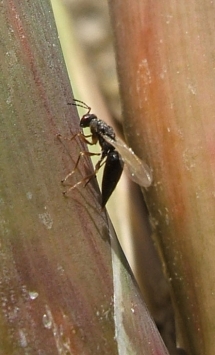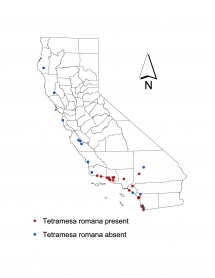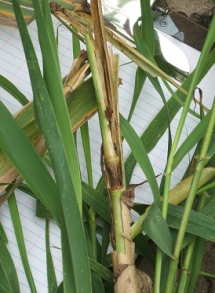Research in our lab focuses on the diversity, impacts, and augmentative release of Arundo herbivores already present in North America, as well as evaluation of novel insects and pathogens for potential use as biological control agents.
Arundo brochure (Sonoma Ecology Center)
Tetramesa romana
During surveys of Arundo infestations in the southwest US, we detected the Arundo wasp (Tetramesa romana) feeding in Arundo stems in southern California in 2006. This European insect was most likely an accidential introduction in this region, although timing and mode of introduction remain unknown. Currently, the wasp is distributed along the California coast from Santa Barbara County south to Baja California in Mexico, but is continuing to expand its range, as we recently (2013) detected new populations in the Mojave River, Victorville, CA.
Naturalized populations have also been found in Texas, so this species has most likely been present in North America for several decades. Additional insect populations from Europe were evaluated and augmentatively released in Texas by the USDA.
Our Lab continues to track the range expansion and population demographics of T. romana in Arundo stands in the southwest US, and evaluate the direct and indirect effects of wasp herbivory on plants.
Cryptonevra sp.
Chloropid flies (Cryptonevra sp.), native to the Mediterranean region, were also found feeding inside canes in localized populations in the Santa Clara River (Ventura County, CA). Feeding produces characteristic ‘hour glass’ damage at the feeding point, and a 'witches broom' effect at the top of canes by stimulating growth of side shoots. Generally these gregarious insects are present at low densities and populations can vary substantially between years.
Melanaphis donacis
The specialist aphid, Melanaphis donacis, was found throughout California (except very northern California) with greatest abundance in coastal Arundo populations. Aphids feed primarily on the apical shoots and less mature, distal leaves, and although reaching high population densities in early spring in some locations, only minor damage was observed on plants in one location. This species is native to the Mediterranean basin.


 Female Arundo wasp (Tetramesa romana) depositing an egg in a young Arundo stem
Female Arundo wasp (Tetramesa romana) depositing an egg in a young Arundo stem Arundo wasp (Tetramesa romana) distribution in California
Arundo wasp (Tetramesa romana) distribution in California Hour glass damage from a shoot fly (Cryptonevra sp.)
Hour glass damage from a shoot fly (Cryptonevra sp.)